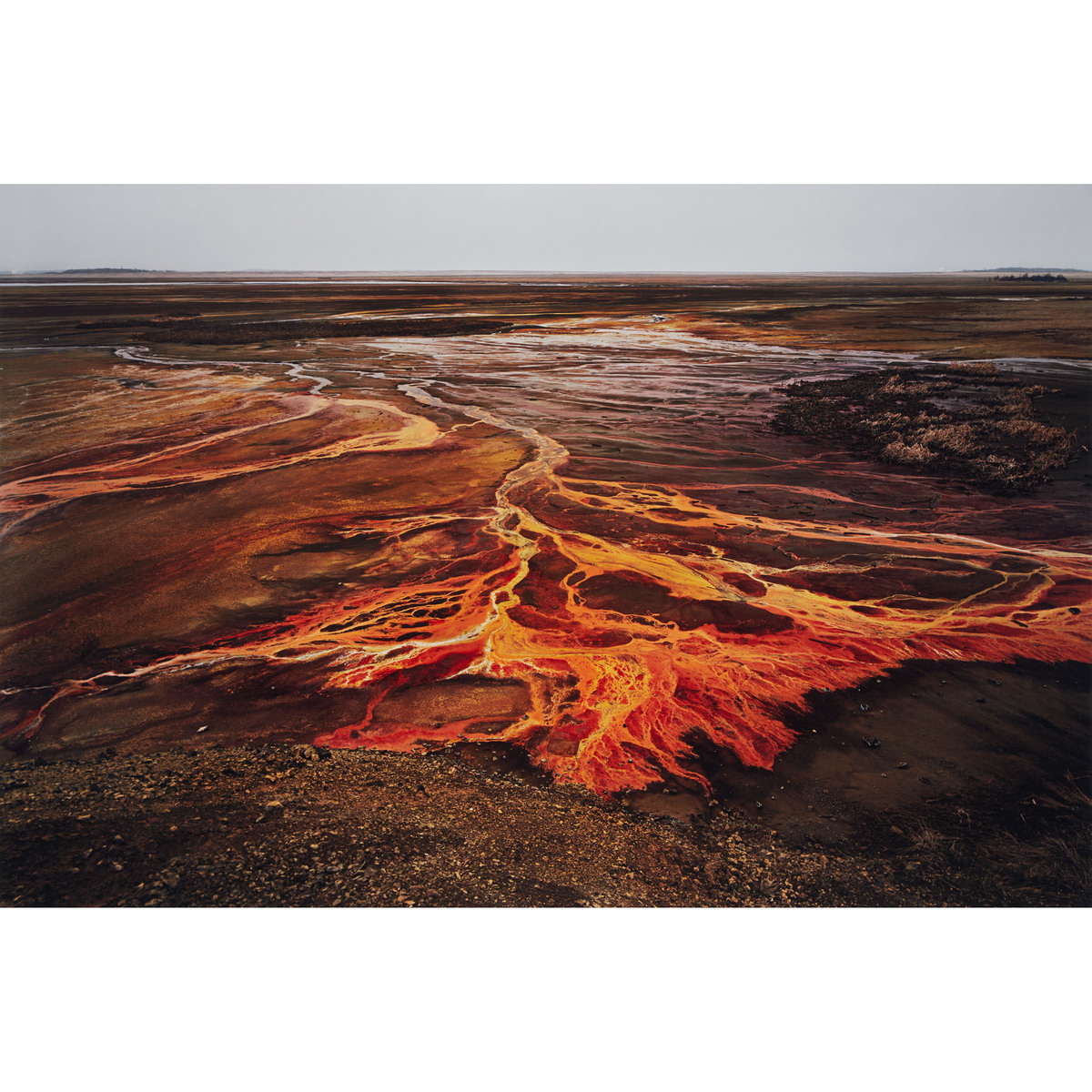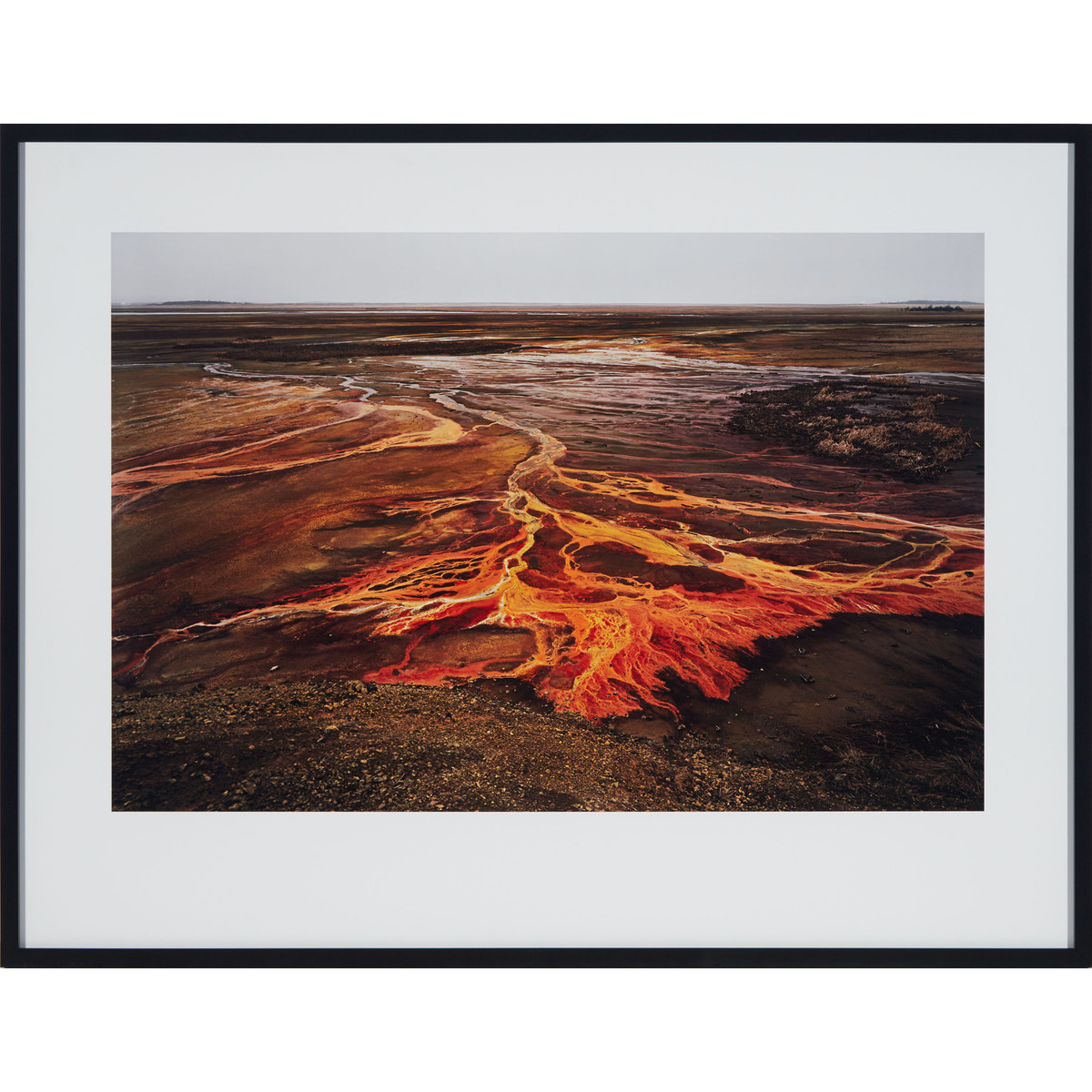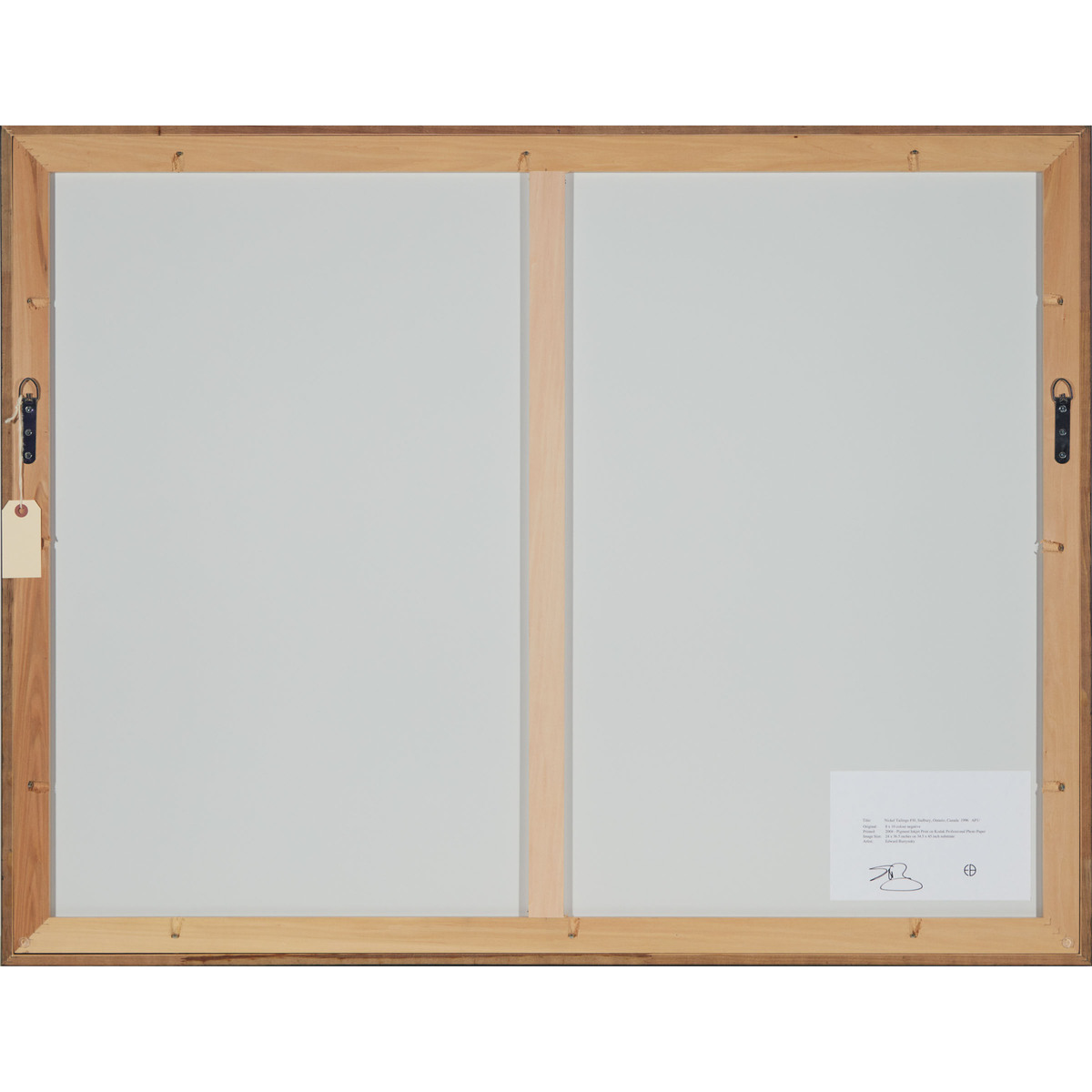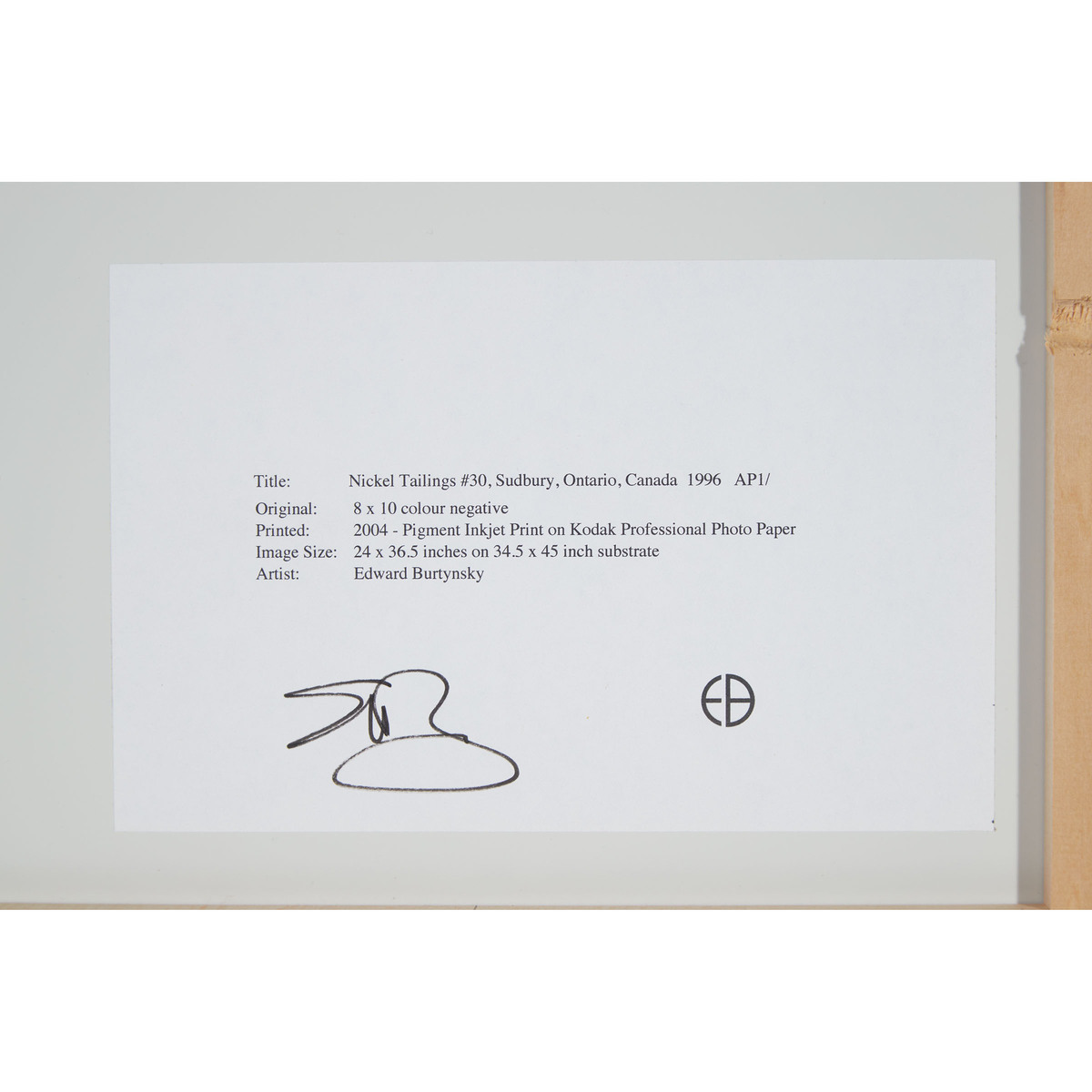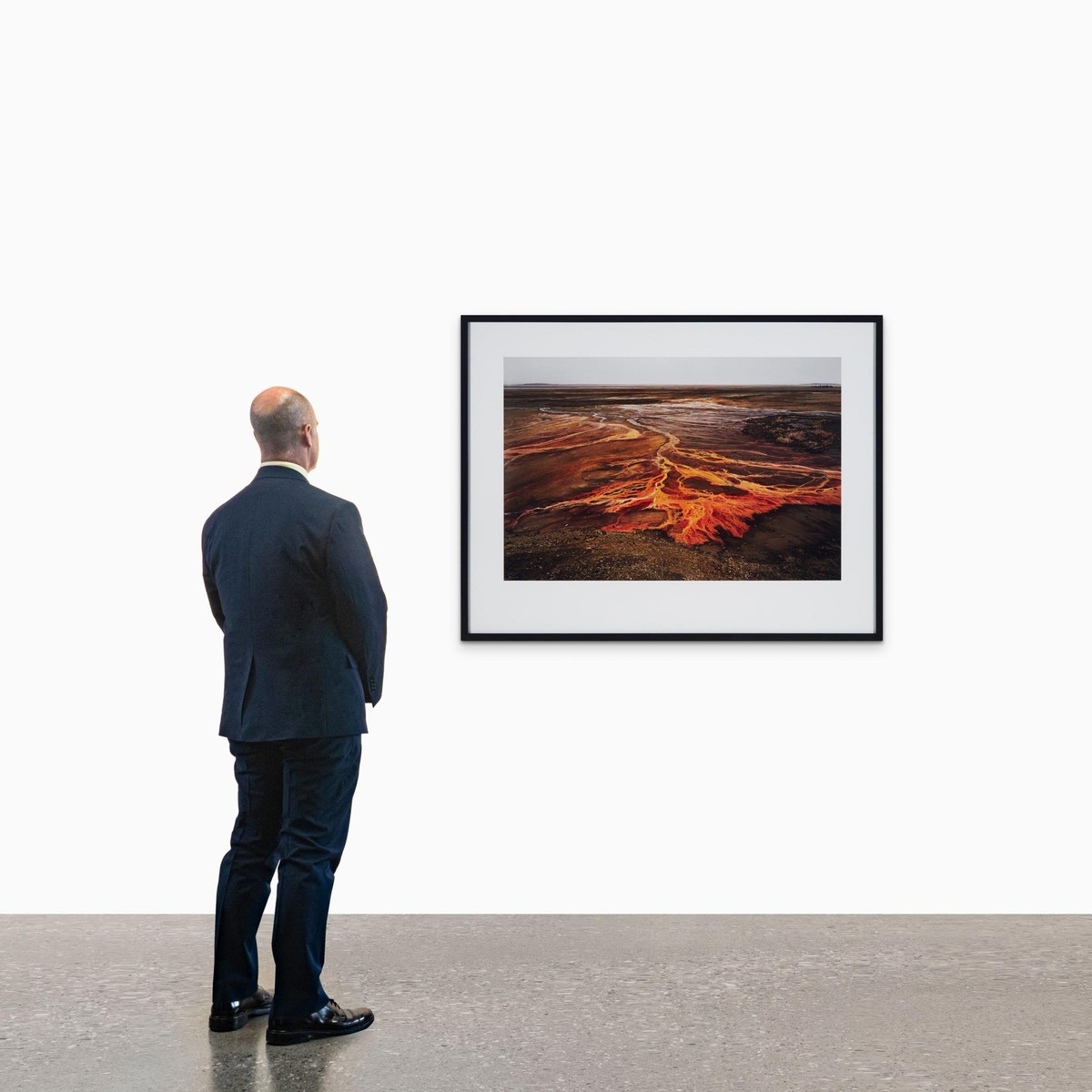33
Edward Burtynsky, RCA (b. 1955), NICKEL TAILINGS #30, SUDBURY, ONTARIO, CANADA, 1996, pigment inkjet
NICKEL TAILINGS #30, SUDBURY, ONTARIO, CANADA, 1996
pigment inkjet print on Kodak Professional photo paper
signed and numbered AP1 to artist label verso
image 24 x 36.5 in — 61 x 92.7 cm
Provenance:
Acquired directly from the artist;
Private Collection, Ontario
Note:
How to explain the great beauty and seductiveness of Edward Burtynsky’s images of destruction? For centuries, humans have been trying to make sense of ruined places, these uneasy landscapes which tend to inspire the sort of deep feelings of impermanence and insignificance that most of us try to keep tucked away in the margins of our waking lives. How do we reconcile the great beauty of this photograph with the environmental price paid?
From the “Mines and Tailings” series, Nickel Tailings #30 mimics the natural world - a bright orange river delta, fingers stretching across the dark earth - but the scene is entirely a result of human intervention.
Burtynsky has said that early in his career, he “started thinking about ruins and the kinds of emotions they provoke. Throughout art history the ruin has been a subject of contemplation, of something melancholy and monumental. I think a lot of what I photograph are the ruins of our society, the ruins in the landscape, the things that are left behind.” (1)
In the Renaissance, artists and viewers were drawn to Greco-Roman ruins, seeking to form a connection with the monuments of a once-great culture. Instead, Burtynsky presents us with a more angst-filled vista: rather than romantic views of civilizations ravaged by time, Burtynsky asks us to look at the civilization doing the ravaging. Put another way, the scenes Burtynsky depicts are not the great achievements of our age, but rather that which facilitates our greatness. They are views of the overlooked, the willfully forgotten—instead of movie stars, Burtynsky takes us backstage to see the janitors, the popcorn-sweepers, and the minimum-wage cleaners.
Eighteenth century historian Edward Gibbon wrote: “if we are more affected by the ruin of a palace than by the conflagration of a cottage, our humanity must have formed a very erroneous estimate of the miseries of human life.” Through Burtynsky’s lens, places that were not supposed to be spaces of reflection or great humanity are allowed to serve as such. Burtynsky notes that his work “function[s] as reflecting pools of our times,” (2) allowing the viewer to arbitrate where these pictures sit on a scale between grandeur and entropy. For Burtynsky, a Sudbury floodplain washed in the remnants of nickel production can have a monumentality equal or greater than the Roman Forum—because unlike the ruins of Rome, these views present us with ourselves.
(1) Michael Torosian, “The Essential Element: An Interview with Edward Burtynsky” in Manufactured Landscapes, ed. Lori Pauli (Ottawa: National Gallery of Canada, 2003), 48.
(2) Edward Burtynsky, “Statement,” accessed September 2023, https://www.edwardburtynsky.com/about/statement.
Estimate: $20,000—30,000
NICKEL TAILINGS #30, SUDBURY, ONTARIO, CANADA, 1996
pigment inkjet print on Kodak Professional photo paper
signed and numbered AP1 to artist label verso
image 24 x 36.5 in — 61 x 92.7 cm
Provenance:
Acquired directly from the artist;
Private Collection, Ontario
Note:
How to explain the great beauty and seductiveness of Edward Burtynsky’s images of destruction? For centuries, humans have been trying to make sense of ruined places, these uneasy landscapes which tend to inspire the sort of deep feelings of impermanence and insignificance that most of us try to keep tucked away in the margins of our waking lives. How do we reconcile the great beauty of this photograph with the environmental price paid?
From the “Mines and Tailings” series, Nickel Tailings #30 mimics the natural world - a bright orange river delta, fingers stretching across the dark earth - but the scene is entirely a result of human intervention.
Burtynsky has said that early in his career, he “started thinking about ruins and the kinds of emotions they provoke. Throughout art history the ruin has been a subject of contemplation, of something melancholy and monumental. I think a lot of what I photograph are the ruins of our society, the ruins in the landscape, the things that are left behind.” (1)
In the Renaissance, artists and viewers were drawn to Greco-Roman ruins, seeking to form a connection with the monuments of a once-great culture. Instead, Burtynsky presents us with a more angst-filled vista: rather than romantic views of civilizations ravaged by time, Burtynsky asks us to look at the civilization doing the ravaging. Put another way, the scenes Burtynsky depicts are not the great achievements of our age, but rather that which facilitates our greatness. They are views of the overlooked, the willfully forgotten—instead of movie stars, Burtynsky takes us backstage to see the janitors, the popcorn-sweepers, and the minimum-wage cleaners.
Eighteenth century historian Edward Gibbon wrote: “if we are more affected by the ruin of a palace than by the conflagration of a cottage, our humanity must have formed a very erroneous estimate of the miseries of human life.” Through Burtynsky’s lens, places that were not supposed to be spaces of reflection or great humanity are allowed to serve as such. Burtynsky notes that his work “function[s] as reflecting pools of our times,” (2) allowing the viewer to arbitrate where these pictures sit on a scale between grandeur and entropy. For Burtynsky, a Sudbury floodplain washed in the remnants of nickel production can have a monumentality equal or greater than the Roman Forum—because unlike the ruins of Rome, these views present us with ourselves.
(1) Michael Torosian, “The Essential Element: An Interview with Edward Burtynsky” in Manufactured Landscapes, ed. Lori Pauli (Ottawa: National Gallery of Canada, 2003), 48.
(2) Edward Burtynsky, “Statement,” accessed September 2023, https://www.edwardburtynsky.com/about/statement.
Estimate: $20,000—30,000
Canadian, International, and Inuit Art
Ends from
Venue Address
For Waddington's delivery information please telephone +1 4165049100.
Important Information
Bidding for this sale will take place entirely online on Waddingtons Online Auction Platform
Waddington’s charges a buyer’s premium of 23% on the hammer price up to and including $25,000 CAD. Hammer prices in excess of $25,000 CAD will be charged a buyer’s premium of 20%. Payment for purchases is accepted in Canadian dollars by cash, certified cheque drawn on a Canadian bank, travelers cheque, bank draft or transfer, Visa or Mastercard within 10 days from the date of the sale.
Terms & Conditions
Terms and conditions:
1. All lots are sold “AS IS”. Any description issued by the auctioneer of an article to be sold is subject to variation to be posted or announced verbally in the auction room prior to the time of sale. While the auctioneer has endeavoured not to mislead in the description issued, and the utmost care is taken to ensure the correct cataloguing of each item, such descriptions are purely statements of opinion and are not intended to constitute a representation to the prospective purchasers and no warranty of the correctness of such description is made. An opportunity for inspection of each article is offered prior to the time of sale. No sale will be set aside on account of lack of correspondence of the article with its description or its reproduction, if any, whether colour or black & white. Some lots are of an age and/or nature which preclude their being in pristine condition and some catalogue descriptions make reference to damage and/or restoration. The lack of such a reference does not imply that a lot is free from defects nor does any reference to certain defects imply the absence of others. Frames on artwork are not included as part of purchase or condition. It is the responsibility of prospective purchasers to inspect or have inspected each lot upon which they wish to bid, relying upon their own advisers, and to bid accordingly.
2. Each lot sold is subject to a premium as part of the purchase price as per below:
Live and Online Auctions
(excluding Canadian Fine Art, Inuit Art, The Art of Canada and Fine Wine & Spirits Auctions)











